Introduction

Source: Love hear, MLBPROD, Open clip art library
Although the genres of fiction, poetry, drama, and literary nonfiction are different, all writing within these genres has themes. Each theme is not merely the topic of the writing but is a truth the author wants the reader to understand. For example, love is a topic commonly explored by writers.
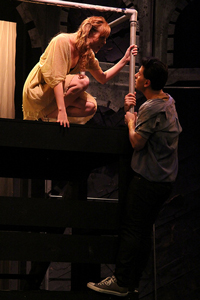
Source: romeo_juliet_0400_filtered, Daniel_dimarco, Flickr
To read a play like Shakespeare’s Romeo and Juliet and to say its theme is “love” is to miss the point that Shakespeare is trying to make about love. Romeo's and Juliet’s families despise each other and forbid the teens’ love. This forbidden love ultimately leads to the deaths of the young lovers. Shakespeare wants us to understand that love is more than an emotion; it is a force that can cause violence and destruction.
Understanding Theme
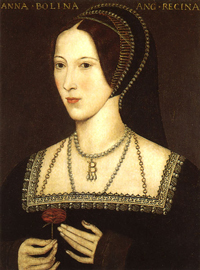
Source: Anneboleyn2, Wikimedia
If theme is a way of seeing the world through the author’s eyes, then as we read works by different authors that tackle the same theme, we will see their differing viewpoints about the same topic.
Let’s take a look at an example. The lines below are from the poem “O Death, Rock Me Asleep” attributed to Anne Boleyn. It was presumably written while she waited for her execution in 1536.
Farewell, my pleasures past,
Welcome, my present pain!
I feel my torments so increase
That life cannot remain.
The theme of this poem is that death is a welcome relief from the torments of life.
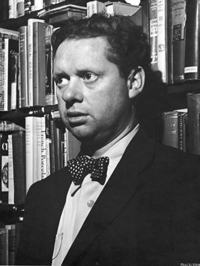
Source: Dylan Thomas photo, Wikipedia
Now, read this stanza from “Do Not Go Gentle Into That Good Night” written by Dylan Thomas in 1951 for his dying father.
Do not go gentle into that good night,
Old age should burn and rave at close of day;
Rage, rage against the dying of the light.
How might you figure out the theme of this poem? You can start by asking questions such as the ones that follow. Even if you can’t answer all of the questions about a work, it’s good to keep them in mind.
- What does the work’s title reveal about the theme?
- What is the context of the work?
- What is the work’s topic?
- What is the work’s tone?
- What lines or words catch your attention?
- What is the point of view?
- What lesson does the narrator or speaker learn?
- What is the conflict?
- What motifs or symbols are used?
- What figurative language is used?
You can find the elements mentioned in the questions above in different types of texts, including fiction, poetry, drama, and even nonfiction. Let’s use the excerpt from the Thomas poem above to see how asking questions might work.
- Title: We know from reading the stanza that “good night” might mean death, and to “not go gentle” might mean to not go willingly or to not go without a fight.
- Context: We know from the lesson that the speaker wrote this for his dying father.
- Topic: Death and how we approach it is the topic.
- Tone: The tone could be anger at the circumstances because the speaker uses words like “rage,” “burn,” and “rave.”
- Lines that grab your attention: “Rage, rage against the dying of the light” grabs our attention because it suggests that a person should fight against death.
- Point of view: The poem is written from the son's point of view about how he regards his father’s dying.
- Lessons learned: We don’t have enough of the poem to be able to answer this question.
- Conflict: We can say the conflict is man against nature or death.
- Motifs or symbols: “Old age” that “burn[s] and rave[s]” could be a central idea or motif and might represent an attitude that the speaker wishes older people would take toward dying.
- Figurative language: “[L]ight” might be a metaphor for life just as the “good night” is a metaphor for death.

Source: Buzz Lightyear Parking Area at Disneyland Resort, tom.arthur, Flickr
Comparing Themes
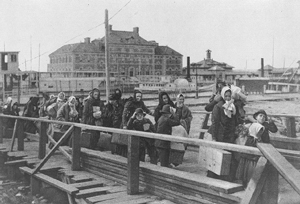
Source: Ellis island 1902, Wikimedia
The immigrant experience is a topic that has been written about extensively in many genres and time periods. Today, the conversation about immigration is mostly focused on undocumented immigrants, specifically the effects of immigrants on our society and resources.
In the late 1800s, the conversation about immigration focused mainly on immigrants from European countries such as Ireland, Germany, Russia, and Italy. Let’s take a look at some texts about immigration from that time and identify their themes.
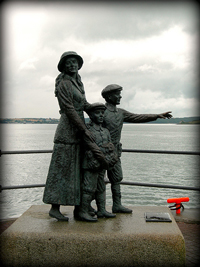
Source: Statue of Annie Moore and her brothers,
Cobh, Ireland, Juan Antonio Flores Segal, Flickr
The first work is an excerpt from the short story “How I Found America” written by Anzia Yezierska in 1920. This is the story of a young Russian Jewish girl who comes to America to escape poverty and the oppression of the Cossacks, who won’t allow her to go to school because she is Jewish. Her family settles in New York City, and even though they no longer live in a mud hut or have to fear being hurt because of their religion, the narrator misses the open fields and sunshine of her homeland.
In New York, she works as a seamstress in a sweatshop until she is fired for confronting the boss about cutting the wages. On her way home from the sweatshop, she is hit by a car and ends up in the hospital. At the hospital, she has a dream of learning in an idyllic school. Her friend Yetta visits and tells her about the School for Immigrant Girls. She immediately goes to the school when she’s released from the hospital. At the school, Anzia meets Mrs. Olney, who suggests she learn a trade and become a servant. The following passage occurs after Anzia tells Mrs. Olney she doesn't want to be a servant.
Mrs. Olney stood abashed a moment. “Well, my dear,” she said deliberately, “what would you like to take up?”
“I got ideas how to make America better, only I don’t know how to say it out. Ain’t there a place I can learn?”
A startled woman stared at me. For a moment not a word came. Then she proceeded with the same kind smile. “It’s nice of you to want to help America, but I think the best way would be for you to learn a trade. That’s what this school is for, to help girls find themselves, and the best way to do is to learn something useful.”
“Ain’t thoughts useful? Does America want only the work from my body, my hands? Ain’t it thoughts that turn over the world?”
“Ah! But we don’t want to turn over the world.” Her voice cooled. “My child, thought requires leisure. The time will come for that. First you must learn to earn a good living.”
“Did I come to America for a living?”
“What did you come for?”
“I came to give out all the fine things that was choked in me in Russia. I came to help America make the new world. . . . They said, in America I could open up my heart and fly free in the air—to sing—to dance—to live—to love . . . Here I got all those grand things in me, and America won’t let me give nothing.”
The narrator then goes home to find her family evicted because of the wages she lost when she was in the hospital. Defeated, she goes back to the sweatshop to work. However, things begin to change at the shop. The shop gets electricity, and the workers get raises. She can finish her work with enough time to go to night school, but eventually she feels that night school isn’t helping her find the America she imagined either. Her young sister comes home from school one day, excited about a teacher who encourages her to express her opinions. The narrator goes to visit the teacher, hoping that she, too, will be inspired.
“I’m an immigrant many years already here, but I’m still seeking America. My dream America is more far from me than it was in the old country. Always something comes between the immigrant and the American,” I went on blindly. “They see only his skin, his outside—not what’s in his heart. They don’t care if he has a heart. . . . I wanted to find someone that would look on me—myself . . . I thought you’d know yourself on a person first off.”
The teacher encourages the narrator to share her story so that the teacher can better understand the situations of her immigrant students. The teacher also reads to the narrator from Our America by Waldo Frank.
All the way home the words she read flamed before me: “We go forth all to seek America. And in the seeking we create her. In the quality of our search shall be the nature of the America that we create. . . .”
So all those lonely years of seeking and praying were not in vain! How glad I was that I had not stopped at the husk—a good job—a good living—but pressed on, through the barriers of materialism.
Through my inarticulate groping and reaching-out I had found the soul—the spirit—of America!
Now, complete this graphic organizer about this story. You can download, save, and print this file. When you are finished with it, return to the lesson. Graphic Organizer Instructions
Read the short poem “Pot O’ Gold” by Kathryn Fitzgerald. This is a contemporary poem written by the grandchild of immigrants. After reading the poem, open a graphic organizer. You can download, save, and print this file. When you are finished with it, go to the next section in this lesson. Graphic Organizer Instructions
Pot O’ Gold
Kathryn Fitzgerald
We came here in search of food
across a tumultuous sea
We came here for a life that’s good;
We'd have stayed home if we could
Máthair cried after we arrived
Each day in the filth she would toil
Athair’d search each day for a wage that was good
to buy food, to buy shoes, to buy wood
They fought long and hard, became loyal and true
To forge a life from something brand new
This immigrants legacy would be seen through
Pulsing through my heart is emerald blood
My grandfather's father’s will, in me
They came here for a life that’s good
I stay here because I could.
Contrasting Themes
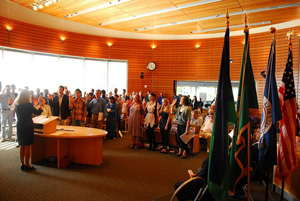
Source: DSC_5793, City of Bellevue, WA, Flickr
When you compare themes in two different texts, you look for similarities and differences in how the themes are portrayed. When you contrast themes, you look for differences. Although two texts might contain the themes of coming to America and looking for respect, there will be both similarities and differences in how these themes are portrayed in each text.
In the previous section, you read texts that dealt with the experience of Russian and Irish immigrants. One of the experiences occurred more than a century ago. Think about current immigration. How has the immigrant experience differed during different time periods?

Source: Jose Antonio Vargas, The Opportunity Agenda, Flickr
To compare and contrast the previous excerpts you read with a contemporary perspective, read an excerpt from a 2011 article “My Life as An Undocumented Immigrant” by Jose Antonio Vargas. Before you read, you’ll need some context for the purposes of analyzing the theme of this excerpt and comparing and contrasting it to the themes of the short story and poem from the previous section. At the turn of the twentieth century, immigrating legally to the United States was relatively easy, provided you could get here. As the numbers of immigrants increased, quotas based on national origin were implemented, and it became increasingly difficult to immigrate to the United States. By the time Jose Antonio Vargas came here, legal immigration was tightly controlled.
Open this graphic organizer to read an excerpt from Vargas’s article. Graphic Organizer Instructions
 Using your notes, answer the following questions:
Using your notes, answer the following questions:
Compare and contrast the theme from “My Life as an Undocumented Immigrant” to the theme of “How I Found America.”
How are they similar? How are they different?
When you’re finished writing your answer, check your understanding to see a possible response.
Understanding how different texts may have similar topics but different themes can be difficult, but knowing how to use a few easy reading strategies and graphic organizers makes comparing and contrasting themes easy, even when you read challenging texts.
Resources
Resources Used in This Lesson: Bibliography
Boleyn, Anne. “O Death, Rock Me Asleep.” Poetry Archive. http://www.poetry-archive.com/b/
o_death_rock_me_asleep.html.
Fitzgerald, Kathryn. “Pot O’ Gold.” Immigrant City: Chicago. Jane Addams Hull Museum, University of Illinois at Chicago. http://www.uic.edu/jaddams/hull/immigrantcitychicago/poems/ fitzgerald_potogold.html.†
Thomas, Dylan. “Do not go gentle into that good night.” Poets.org. http://www.poets.org/viewmedia.php/prmMID/
15377#sthash.IZPzmEAB.dpuf.
Vargas, Jose Antonio. “My Life as an Undocumented Immigrant.” New York Times, June 22, 2011. http://www.nytimes.com/2011/06/26/magazine/my-life-as-an-undocumented-immigrant.html
?pagewanted=all.
Yezierska, Anzia. “How I Found America.” Hungry Hearts. Project Gutenberg. October 30, 2012. http://www.gutenberg.org/files/41232/41232-h/41232-h.htm#Page_250.
†Republished with permission from author